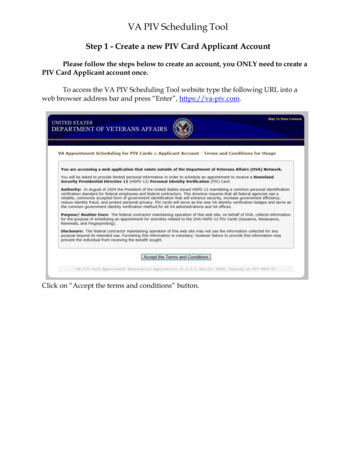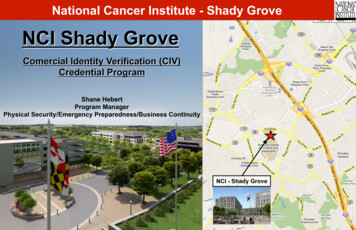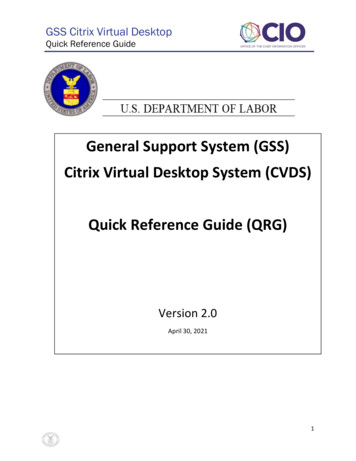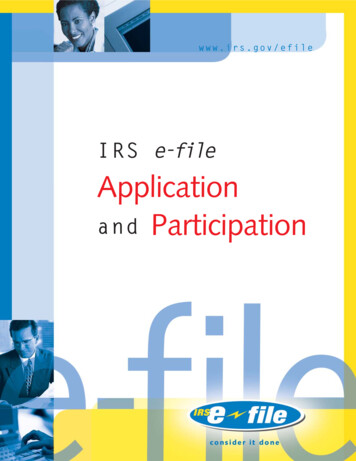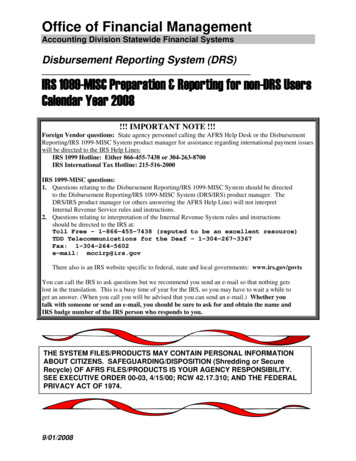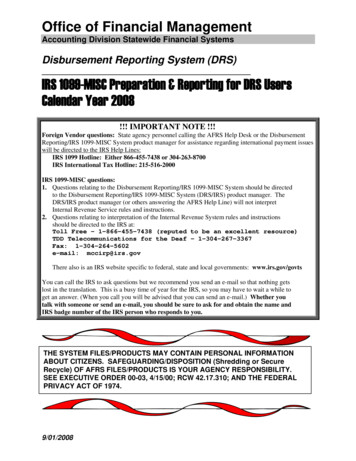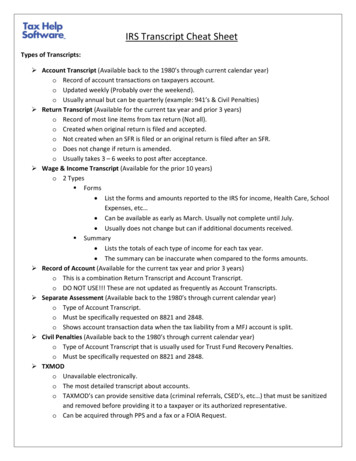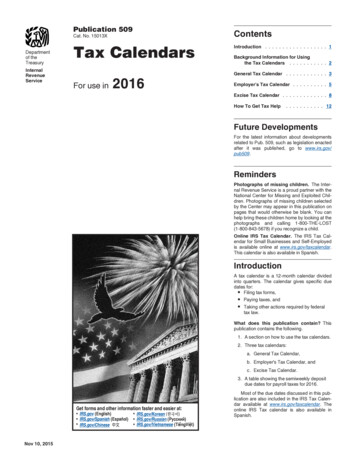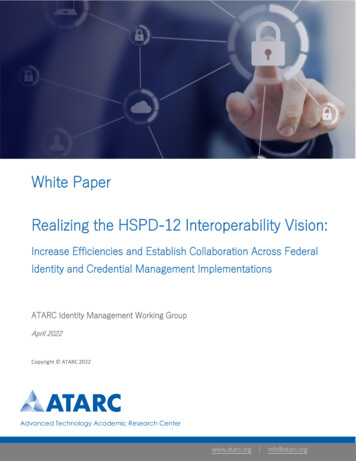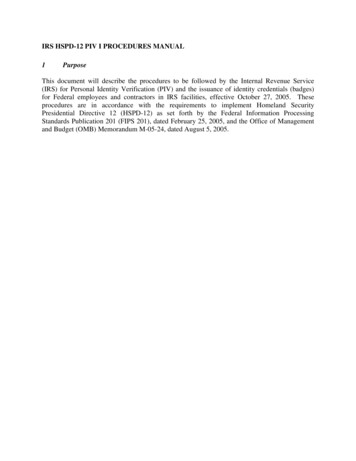
Transcription
IRS HSPD-12 PIV I PROCEDURES MANUAL1PurposeThis document will describe the procedures to be followed by the Internal Revenue Service(IRS) for Personal Identity Verification (PIV) and the issuance of identity credentials (badges)for Federal employees and contractors in IRS facilities, effective October 27, 2005. Theseprocedures are in accordance with the requirements to implement Homeland SecurityPresidential Directive 12 (HSPD-12) as set forth by the Federal Information ProcessingStandards Publication 201 (FIPS 201), dated February 25, 2005, and the Office of Managementand Budget (OMB) Memorandum M-05-24, dated August 5, 2005.
2HSPD-12 Overview2.1What is HSPD-12?HSPD-12 was signed on August 27, 2004. This directive instructs all Federal agencies todevelop a common procedure for secure and reliable forms of identification to be used byFederal employees and contractors to gain access to Federal facilities. This new procedure willenhance security, increase government efficiency, reduce identity fraud, and protect personalprivacy.HSPD-12 directed the Department of Commerce to develop FIPS 201, which defines thestandards to be used in developing a common procedure across all government agencies. Inaddition, the OMB issued M-05-24 which further clarifies the schedule and implementation planfor this standard, which will be implemented in two major phases – PIV-I and PIV-II.2.2PIV I and PIV IIThe first phase, or PIV-I, is the focus of this document and must be implemented by all Federalagencies on October 27, 2005. It establishes the minimum requirements for a process to meetcontrol and security of objectives of HSPD-12, including personal identity proofing, registration,and issuance. It does not address the interoperability objectives of PIV Cards and systemsamong departments and agencies, which will be addressed in PIV-II, with new cards beingissued starting on October 27, 2006.2.3ApplicabilityLong-term - The IRS must conduct a background investigation; adjudicate the results, and issueidentity credentials to all employees and contractors who require long-term access to IRSfacilities and/or information systems. Long-term access is defined as equal to or greater than six(6) months. Candidates that apply for appointments that are long-term, will be required toundergo the PIV process defined in this manual.Temporary - Temporary employees or contractors will be classified in two categories:Temporary short-term and Temporary long-term. Temporary short-term employees or contractors will be defined as working 180calendar days or less. Fingerprints will be taken and the Federal Bureau of Investigation(FBI) Criminal check will be completed on temporary short-term employees orcontractors, however a background investigation will not be required. Employees orcontractors requiring routine access to the IRS for less than 180 days over a period oftime may also be considered in this category. Individuals in this category will be issued avisitor badge. However, the IRS may make a risk-based decision depending on the risklevel of the work to be performed, that additional screening and background checks maybe required.J-2
Temporary long-term employees or contractors will be defined as working more than180 calendar days. Individuals in this category will adhere to the same criteria as definedin the Long-term access paragraph above, and must adhere to the PIV process.Contractors who will work more than 30 days and require access to the facility or to IRSsystems will be required to adhere to the PIV requirements, depending on the risk levelassessment.Short-term - Short-term contractors, volunteers, commissions, and panels will be defined asworking 1 month or less. For individuals in this category, a visitor badge will be issued and noFBI Criminal check or background investigation will be conducted. However, the IRS maymake a risk-based decision depending on the risk level of the work to be performed, thatfingerprints, additional screening, and background checks will be required.Visitors - HSPD-12 does not apply to occasional visitors to the IRS facilities, such as volunteersor family members. Visitors will be issued a visitor badge.Foreign Nationals – Contractors and sub-contractors and their employees may be allowed towork at the IRS if they are US citizens or have lawful permanent resident status. A foreignnational is defined as a person who was born in a foreign country, is NOT a US citizen, and has alawful permanent resident status. Background investigations for foreign nationals will beconducted on all contractors according to the procedures outlined in the Treasury SecurityManual – TDP 71-10, Chapter 2, Section 2 - Contractor Investigations. IRS hiring policy statesthat an individual must be a US citizen in order to be considered for employment eligibility.Therefore, foreign nationals are currently not IRS employees.2.4Certification & AccreditationThe PIV processes outlined in this document for identity proofing and registration, as well as forissuance and maintenance of PIV Cards, will be submitted and incorporated in the BusinessProcess Accreditation Template for approval and accreditation by the proper authorities withinthe IRS and the Department of the Treasury. All of the processes outlined here satisfy therequirements of FIPS 201 and OMB M-05-24. The requirements for this certification areoutlined in the National Institute of Standards and Technology (NIST) Special Publication 80079 (SP 800-79). The Designated Accreditation Authority (DAA) has given the IRS anAuthorization to Operate (ATO) effective October 27, 2005.J-3
3Requirements for PIV-IRequirements for personal identity verification are specified in Federal Information ProcessingStandards Publication 201 - Personal Identity Verification of Federal Employees andContractors, issued by the National Institute of Standards and Technology (NIST). This standardcontains requirements for PIV-I and PIV-II. An appendix to the standard contains two exampleidentity proofing, registration and issuance process sets which meet the requirements for PIV: arole-based model and a system-based model. The role-based model is recommended fororganizations which do not have a pre-existing PIV system.3.1Control ObjectivesHSPD-12 established control objectives to establish what is meant by “secure and reliable formsof identification”; FIPS 201 expands those control objectives to the following set of high-levelrequirements: Credentials are issued to individuals whose true identity has been verified and after aproper authority has authorized issuance of the credential;Only an individual with a background investigation initiated or on record is issued acredential; If background check is not completed within 5 days, an interim credential canbe issued based on a successful fingerprint check;An individual is issued a credential only after presenting two identity source documents,at least one of which is a valid Federal or State government issued picture identificationdocument (ID);Fraudulent identity source documents are not accepted as genuine and unaltered;A person suspected or known to the government as being a terrorist is not issued acredential;No substitution occurs in the identity proofing process. More specifically, the individualwho appears for identity proofing, and whose fingerprints are checked against databases,is the person to whom the credential is issued;No credential is issued unless requested by proper authority;A credential remains serviceable only up to its expiration date. More precisely, arevocation process exists such that expired or invalidated credentials are swiftly revoked;A single corrupt official in the process may not issue a credential;An issued credential is not modified, duplicated, or forged.J-4
3.2Identity Proofing and Registration RequirementsIdentity proofing is the process of providing sufficient information (to a PIV Registrar or trustedagent) to establish a person’s identity. Identity registration includes the collecting and recordingof relevant attributes of that person, and associating that information with the unique identifier ofthat person. 3.3The process shall begin with initiation of a National Agency Check with WrittenInquiries (NACI) or other OPM or National Security investigation required for Federalemployment. This requirement may also be satisfied by locating and referencing acompleted and successfully adjudicated NACI, or other OPM or National Securityinvestigation required for Federal employment. Additional OMB guidance in M-05-24states that, if the results of the NAC are not received in 5 days, the identity credential canbe issued based on the FBI National Criminal History Check (fingerprint check).The Applicant must appear in-person at least once before the issuance of a PIVcredential.During identity proofing, the Applicant shall be required to provide two forms of identitysource documents in original form. The identity source documents must come from thelist of acceptable documents included in Form I-9, OMB No. 1115-0136, EmploymentEligibility Verification. At least one document shall be a valid State or Federalgovernment-issued picture identification.The PIV identity proofing, registration and issuance process shall adhere to the principalof separation of duties to ensure that no single individual has the capability to issue a PIVcredential without the cooperation of another authorized person.Issuance and Maintenance RequirementsIssuance of a PIV credential includes creation and personalization of the credential and givingthe credential (in person) to the Applicant after verifying that the individual who collects thecredential is in fact the Applicant for whom the credential is intended. The process shall ensure completion and successful adjudication of a National AgencyCheck (NAC), NACI, or other OPM or National Security investigation as required forFederal employment. The PIV credential shall be revoked if the results of theinvestigation so justify. Additional OMB guidance in M-05-24 states that, if the resultsof the NAC are not received in 5 days, the identity credential can be issued based on theFBI National Criminal History Check (fingerprint check).At the time of issuance, verify that the individual to whom the credential is to be issued(and on whom the background investigation was completed) is the same as the intendedApplicant/recipient as approved by the appropriate authority.The organization shall issue PIV credentials only through systems and providers whosereliability has been established by the agency and so documented and approved inwriting.J-5
4PIV-I RolesWith the implementation of FIPS 201 requirements, several new roles have been identified thatare key elements of the PIV process. These new roles are described below and are also outlinedin the example role-based model included in Appendix A. of FIPS 201.4.1Role RequirementsOne of the requirements of the PIV identity proofing, registration, and issuance process is toensure that the principal of separation of duties is met. In order to distinguish a clear separationof responsibilities between roles, the IRS will adopt the first four role names and descriptionsthat are outlined in the FIPS 201 Section A.1.1.1 Roles and Responsibilities.Named individuals within the existing IRS and contractor organizations may be designated to arole that they will perform in the PIV process. These individuals must complete training in theirdesignated role. A list of individuals within each role will be maintained by the IRS HSPD-12Program Office. This list will be distributed to each of the card issuing facilities. Individualsmay be designated to more than one role, however they may not perform more than one role fora single PIV Card Applicant (as defined below). All individuals performing a PIV role musthave a completed and favorably adjudicated NACI check on record.Per the FIPS 201 requirements, each PIV role performed will be mutually exclusive from anyother role performed for each PIV Card Applicant. In the FIPS 201 requirements, Appendix A,an example of a Role Based Model is illustrated as an approved example of PIV IdentityProofing, Registration and Issuance. The IRS will be adopting a similar model, using the rolesdescribed in the FIPS 201 requirements Appendix A, however slight variations have been madeto accommodate the specific business needs of the IRS. The variations in the IRS model adoptthe use of an approved identity proofing and registration process as outlined in Section 2.2 of theFIPS 201 requirements and satisfy the PIV objectives and requirements.4.2Role DescriptionsThe following describes the five critical roles that will be employed at the IRS for identityproofing and issuance: The PIV Sponsor, Registrar, and Issuer will be named individuals thathave been certified and trained to perform their designated role. A list will be maintained forindividuals serving in these roles and a record of their completed background investigation willbe kept on file. The PIV Applicant Representative is also a new IRS role that serves to protectthe Applicant’s rights.4.2.1ApplicantThis is the individual to whom a PIV credential potentially needs to be issued.4.2.2PIV SponsorThis is the individual who substantiates the need for a PIV credential to be issuedto the Applicant, and provides sponsorship to the Applicant. The PIV Sponsorrequests the issuance of a PIV credential to the Applicant.J-6
4.2.3 PIV RegistrarThis is the entity responsible for identity proofing of the Applicant and ensuringthe successful completion of the background checks. The PIV Registrar providesthe final approval for the initial issuance of a PIV credential to the Applicant.4.2.4 PIV IssuerThis is the entity that performs credential personalization operations and issuesthe identity credential to the Applicant after all identity proofing, backgroundchecks, and related approvals have been completed. The PIV Issuer is alsoresponsible for maintaining records and controls for PIV credential stock toensure that stock is only used to issue valid credentials.4.2.5PIV Applicant RepresentativeThe PIV Card Applicant Representative is the entity that represents the interestsof current or prospective Federal employees and contractors who are theApplicants for PIV Cards. They should represent the privacy concerns ofapplicants, assist an applicant who is denied a PIV Card because of missing orincorrect information in an Identity Source document, or act as a surrogate for anapplicant that is not available for performing required actions.J-7
5New PIV FormsWith the implementation of the new PIV process, two new forms and an informational guidehave been developed by the IRS. These forms will assist in tracking and documenting the PIVprocess through the various roles / organizations and provide assurance that all of the propersteps have been taken in meeting PIV I compliance. A description of each of these documents isprovided in this section and copies of the forms are provided in Appendix B. All of thesedocuments satisfy the privacy requirements outlined in Section 8 of this manual and will adhereto current IRS record retention policies.5.1PIV Applicant Rights and Responsibilities GuideThe PIV Applicant Rights & Responsibilities Guide (Applicant Guide) will be given to eachindividual at the start of the hiring process. The Applicant Guide explains what to expect in thePIV process, the Applicant’s privacy and appeal rights, and who to contact for questions. Acopy of Applicant Guide is included in Appendix B.5.2PIV Request FormA new tracking form will be utilized to ensure that each step in the process is completedsatisfactorily. The PIV Request Form will be signed by each of the roles mentioned in Section3.1.2 and will document the authorizations for sponsorship, registration, and issuance of the PIVcredential for the life of the credential. Finally, the new form will allow for a signature from theApplicant, indicating that important information about his/her rights was provided and thathis/her permission to participate in the PIV process was granted.The PIV Request Form will be checked by the PIV Issuer, who will ensure that the requirementfor separation of duties has been met and that all of the steps in the process were completed. Thecompleted PIV Request Form will authorize the Issuer to create a PIV credential for theApplicant. The original, signed PIV Request Forms will be stored in Physical Security in asecure location and follow current security and privacy procedures. The PIV Request Forms willbe kept for the life of the PIV credential itself.5.3Contractor Risk Assessment ChecklistThis new form will be used to document and communicate the risk for the type of backgroundinvestigations to be performed on contractors. All new investigation packages will require thischecklist to be submitted to the Procurement Sponsor Team. A copy is included in Appendix B.J-8
6PIV-I ProcessesThe PIV-I processes contain detailed step-by-step instructions and are organized into three mainprocess streams: 1) Identity proofing and registration, 2) PIV Card issuance, and 3) PIV Cardmaintenance. This structure follows the organization of the FIPS 201 requirements and together,they form the entire PIV life cycle for employees and contractors.Throughout these processes, identity documents, investigation paperwork, and the PIV RequestForm are passed through various organizations performing specific roles in the process. In everyinstance where an Applicant’s private information is indicated on a form, the document must betransferred in a secure manner to protect the Applicant’s privacy rights. Secure manner includesthe following forms of transmission: hand-delivery, secure e-mail, fax (if the fax machine is in asecure location), courier, registered USPS mail, and UPS delivery.6.1Identity Proofing and Registration6.1.1New EmployeesThe processes of identity proofing and registration are applied to Applicants foremployment with the IRS as part of the hiring process, so that successful Applicants canbe issued credentials promptly at Entry On Duty (EOD) for facility access. Specifics ofthe hiring process at IRS vary depending on the type of position being filled, and as aresult there are slight variations in how the PIV identity proofing and registration isperformed. The elements of identity-proofing and registration processes which arecommon to most types of hiring are presented here, with indications given wherevariations occur in some hiring types. It is important to ensure that in all hiringsituations, the NACI or other relevant background investigation is initiated at least 5 daysprior to Entry on Duty (EOD). All applicable existing privacy and record retentionpolicies will be applied to this process. Refer to the Section 8 Privacy Considerations.Step 1: Applicant Applies for Federal Credential/Position - The Applicantapplies for a position by submitting an application for a current vacancyannouncement. The submission can be online (via CareerConnector), or a paperapplication via mail or fax. The vacancy announcement includes wording on therequirements for a PIV credential, the privacy statement, as well as wording thatthe position requires a probationary period.Step 2: Initial Assessment of Qualification - In most cases Human Resources(HR) makes an initial assessment of the Applicant’s qualifications relative to thevacancy announcement/position requirements. This can be done based on theapplication materials, through a test administered online (CareerConnector), orthrough a test/assessment administered in person at an IRS test site. In this step,HR determines whether to proceed to perform identity proofing and takefingerprints for a Fingerprint Check.J-9
Step 3: Initiate PIV Request Form - In a face to face meeting with theApplicant, the Registrar (HR) initiates the PIV Request Form for the Applicant.The Registrar provides the Applicant Guide to the Applicant. The optionalinformation in Section 1 of the PIV Request Form is not needed, since thatinformation is collected as part of the fingerprinting process (Step 5). TheApplicant’s signature will verify that he/she agrees to undergo the PIV process. Ifthe Applicant has not already received the Applicant Guide describing the PIVprocess, a copy will be provided at this step. The Applicant Guide will containinformation about the Applicant’s appeal rights, privacy, and contact information.Section 1 of the form is completed and then signed by the Applicant. TheSponsor signature will be left blank until the final determination is made in a laterstep.Step 4: In-Person Identity Proofing - The Registrar (HR) checks a state orfederal government-issued picture ID, as well as one other form of ID inaccordance with the I-9 process. The I-9 form and other necessary forms areverified. If the Applicant does not present a valid ID, the Applicant is escortedfrom the building. If a document is thought to be fraudulent, the Registrar willnotate on the PIV Request Form that there is reason to suspect the document isfraudulent and the reason why. The Applicant will be notified at a later time thatthe identity documents were not valid. ID verification is logged on the PIVRequest Form by the Registrar.Step 5: Obtain Fingerprints - The Registrar (HR) verifies that the Applicantcompletes the Consent for Fingerprint Check form and the Declaration for FederalEmployment. Fingerprints are taken from the Applicant using Livescan or Ink &Roll. If any further information relating to PIV is required from the Applicant,notice is given at this point with a suspense date for providing the missinginformation. Please refer to IRM 1.23.3 Background Investigations Guide foradditional details on how to take fingerprints.Step 6: Initiate FBI Criminal Check - Fingerprints are transmitted to OPM bythe Registrar (HR), in most cases by electronic means. The PIV Request Form isupdated by the Registrar with the date that the FBI Criminal check was initiated.Please refer to IRM 1.23.3 Background Investigations Guide for additional detailson how to transmit fingerprints to OPM.Step 7: Results of Checks - If the FBI Criminal check results are favorable, theresults are entered on the PIV Request Form and the form is signed by theRegistrar. If the results are non-favorable, the results are entered on the PIVRequest Form, and the form is signed by the Registrar. Please refer to Policy 67,Objections and Passovers on Suitability Issues and Suitability AdjudicativeDetermination Procedures for additional details on how to adjudicate the FBICriminal check results.J-10
Step 8: Decision on Hiring/Need for Credential - HR and/or Business Unitmakes a determination on hiring, including: certifying the Applicant, determiningsuitability, evaluating selection criteria, and making the job offer. A decision tomake a job offer requires a favorable outcome from the FBI criminal check.In addition, any concerns over a fraudulent identity document that were noted onthe PIV Request Form, must be resolved prior to making a job offer. If thefraudulent identity document question has not been resolved, HR and/or BusinessUnit must contact the Applicant and ask them to correct the situation by bringingin a valid identity document and having it re-verified. When the Applicantpresents a new, valid identity document, HR and/or Business Unit will update thenotation on the PIV Request Form that the suspected document has been cleared.In the event of an unfavorable decision on hiring, HR retains the forms and theapplication information at least through the duration of the hiring season.Step 9: Initiate Background Investigation - The Registrar (HR) initiates theBackground Investigation – National Agency Check with Inquiries and updatesthe PIV Request Form. The package of investigation paperwork, including therequired form SF-85, SF-85P, or SF-86, is mailed to OMB or NBIC depending onthe type of background investigation. NBIC provides notification of receipt of thepackage back to the Registrar. Please refer to IRM 1.23.3 BackgroundInvestigations Guide for additional details on how to initiate a BackgroundInvestigation.Step 10: Final Determination - The Sponsor (usually another HR officialwithin the same Employment Branch office as the Registrar) signs the PIVRequest Form indicating a final determination on the validity of a need for a PIVcredential.Step 11: Notify Issuer - The Registrar verifies that all applicable sections of thePIV Request Form have been completed properly and that 5 days have elapsedfrom the initiation of the background check. The Registrar then forwards theform via secure means to the Issuer. The Issuer (Physical Security) is notified bythe Sponsor (HR) to initiate credential issuance, at a date no earlier than 5 daysfrom the initiation of the background investigation.Step 12: Complete Background Investigation - When the Registrar is notifiedthat the final adjudication of the background investigation has been completed;the Registrar will notify the Issuer of the final disposition in a secure manner.6.1.2New ContractorsJ-11
Individuals assigned to perform work under IRS contracts, and who require physicalaccess, or access to systems and information, need identity credentials. The process ofidentity proofing and registration for these contractors varies depending on the type ofwork being performed, and the contractor organization. The elements of identityproofing and registration which are common to most types of contractors are presentedhere, with indications given where variations occur. All applicable existing privacy andrecord retention policies will be applied to this process. Refer to the Section 8 PrivacyConsiderations. In this section, the Contracting Officer’s Technical Representative(COTR) is the person responsible for assembling and transferring information to andfrom the Sponsor and the Registrar, however this individual is not designated to performeither of these roles. The COTR may reside in any organization within the IRS thatmanages a contract for services.Step 1: Apply for Credential - The Applicant/employee submits a requestthrough the contractor organization for a credential under a valid contract/taskorder to the COTR for that contract. The applicant provides identity information(First Name, Middle Initial (MI), Last Name, Social Security Number (SSN),contractor company name, contract number) to the COTR.Step 2: Validate Need and Risk Level - The COTR validates the need for acredential under the contract/task order terms and statement of work, and makes adetermination of the appropriate risk level and investigation type based on theduties to be performed. The COTR completes a risk assessment checklist for theApplicant which includes the identity information from Step 1, as well as the RiskLevel/Investigation Type, Contractor Duties, and Duty Location/Issuing Office.The risk assessment checklist is included in the Appendix.Step 3: Initiate Investigation Request - The COTR initiates a PIV RequestForm for the Applicant and provides the Applicant with the PIV Applicant Guide.The Applicant Guide will contain information about the PIV I process, theApplicant’s appeal and privacy rights, and contact information. The COTRcompletes the Applicant Information (Section 1) of the PIV Request Form, andobtains the Applicant’s signature, leaving the Sponsor signature line blank.Step 4: Initiate Investigation Record - The COTR sends the PIV RequestForm and risk assessment checklist to the Procurement Sponsor Team (PST)using secure means to initiate the investigation record in the ProcurementBackground Investigation Process (PBIP) system, and provides the followinginformation: Standard Employee Identifier (SEID) of the COTR or Point of Contact inthe Automated Background Investigation System (ABIS). Fingerprinting source: IRS Human Resources (HR) and / or ExternalTrusted Agent (ETA).Step 5: Create Investigation Record in PBIP - The PST, acting as theSponsor, initiates an Applicant record in PBIP. The PST signs the PIV RequestForm as the Sponsor, and returns the form to the COTR.J-12
Step 6: Perform Identity Proofing and Fingerprinting - When IRS (HR)performs the function as Registrar for identity proofing and fingerprinting, theCOTR will contact HR to schedule an appointment for the applicant. The COTRwill also forward the PIV Request Form, either in person or via secure mail, to theappropriate HR office. (Note: The PIV Request Form should never be brought tothe appointment by the applicant as the chain of custody of the document wouldno longer be secure.) The COTR notifies the Applicant of the time and locationof the appointment and the required identity documents that must be brought bythe applicant to the appointment. In a face-to-face meeting with the Applicant, the Registrar (HR)checks a state or federal government-issued picture ID, as well as oneother form of ID from the list of documents accepted per the I-9(Employment Eligibility Verification) process.If the Applicant does not present a valid ID the identity proofing andfingerprinting does not proceed. The applicant is informed of theacceptable forms of ID and is given the opportunity to reschedule theappointment.If any document is thought to be fraudulent, it will be notated on thePIV Request Form that there is reason to suspect the document isfraudulent and the reason why. The Applicant will be notified at alater time that the identity documents were not valid.The Registrar (HR) completes and signs Section 2A of the PIV Request Form.The Registrar (HR) verifies that the Applicant has completed Form 12333,Consent for Fingerprint Check. HR sends the PIV Request Form and Form 12333to Personnel Security and Investigations (PS&I) Contractor Program via securemail.HR will obtain fingerprints from the Applicant using Livescan or Ink & Roll. HRwill transmit
Presidential Directive 12 (HSPD-12) as set forth by the Federal Information Processing Standards Publication 201 (FIPS 201), dated February 25, 2005, and the Office of Management and Budget (OMB) Memorandum M-05-24, dated August 5, 2005. 2 HSPD-12 Overview . 2.1 What is HSPD-12?
